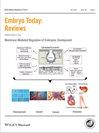Kathleen E. Whitlock
下载PDF
{"title":"The loss of scents: Do defects in olfactory sensory neuron development underlie human disease?","authors":"Kathleen E. Whitlock","doi":"10.1002/bdrc.21094","DOIUrl":null,"url":null,"abstract":"<p>The olfactory system is a fascinating and beguiling sensory system: olfactory sensory neurons detect odors underlying behaviors essential for mate choice, food selection, and escape from predators, among others. These sensory neurons are unique in that they have dendrites contacting the outside world, yet their first synapse lies in the central nervous system. The information entering the central nervous system is used to create odor memories that play a profound role in recognition of individuals, places, and appropriate foods. Here, the structure of the olfactory epithelium is given as an overview to discuss the origin of the olfactory placode, the plasticity of the olfactory sensory neurons, and finally the origins of the gonadotropin-releasing hormone neuroendocrine cells. For the purposes of this review, the development of the peripheral sensory system will be analyzed, incorporating recently published studies highlighting the potential novelties in development mechanisms. Specifically, an emerging model where the olfactory epithelium and olfactory bulb develop simultaneously from a continuous neurectoderm patterned at the end of gastrulation, and the multiple origins of the gonadotropin-releasing hormone neuroendocrine cells associated with the olfactory sensory system development will be presented. Advances in the understanding of the basic mechanisms underlying olfactory sensory system development allows for a more thorough understanding of the potential causes of human disease. Birth Defects Research (Part C) 105:114–125, 2015. © 2015 Wiley Periodicals, Inc.</p>","PeriodicalId":55352,"journal":{"name":"Birth Defects Research Part C-Embryo Today-Reviews","volume":"105 2","pages":"114-125"},"PeriodicalIF":0.0000,"publicationDate":"2015-06-25","publicationTypes":"Journal Article","fieldsOfStudy":null,"isOpenAccess":false,"openAccessPdf":"https://sci-hub-pdf.com/10.1002/bdrc.21094","citationCount":"15","resultStr":null,"platform":"Semanticscholar","paperid":null,"PeriodicalName":"Birth Defects Research Part C-Embryo Today-Reviews","FirstCategoryId":"1085","ListUrlMain":"https://onlinelibrary.wiley.com/doi/10.1002/bdrc.21094","RegionNum":0,"RegionCategory":null,"ArticlePicture":[],"TitleCN":null,"AbstractTextCN":null,"PMCID":null,"EPubDate":"","PubModel":"","JCR":"Q","JCRName":"Medicine","Score":null,"Total":0}
引用次数: 15
引用
批量引用
Abstract
The olfactory system is a fascinating and beguiling sensory system: olfactory sensory neurons detect odors underlying behaviors essential for mate choice, food selection, and escape from predators, among others. These sensory neurons are unique in that they have dendrites contacting the outside world, yet their first synapse lies in the central nervous system. The information entering the central nervous system is used to create odor memories that play a profound role in recognition of individuals, places, and appropriate foods. Here, the structure of the olfactory epithelium is given as an overview to discuss the origin of the olfactory placode, the plasticity of the olfactory sensory neurons, and finally the origins of the gonadotropin-releasing hormone neuroendocrine cells. For the purposes of this review, the development of the peripheral sensory system will be analyzed, incorporating recently published studies highlighting the potential novelties in development mechanisms. Specifically, an emerging model where the olfactory epithelium and olfactory bulb develop simultaneously from a continuous neurectoderm patterned at the end of gastrulation, and the multiple origins of the gonadotropin-releasing hormone neuroendocrine cells associated with the olfactory sensory system development will be presented. Advances in the understanding of the basic mechanisms underlying olfactory sensory system development allows for a more thorough understanding of the potential causes of human disease. Birth Defects Research (Part C) 105:114–125, 2015. © 2015 Wiley Periodicals, Inc.
嗅觉丧失:嗅觉感觉神经元发育缺陷是人类疾病的基础吗?
嗅觉系统是一个迷人而迷人的感觉系统:嗅觉感觉神经元探测到的气味是择偶、食物选择和逃离捕食者等行为所必需的。这些感觉神经元的独特之处在于,它们的树突与外界联系,但它们的第一个突触位于中枢神经系统。进入中枢神经系统的信息被用来制造气味记忆,这些气味记忆在识别个体、地点和适当的食物方面发挥着深远的作用。本文以嗅觉上皮结构为综述,讨论嗅觉基板的起源、嗅觉感觉神经元的可塑性以及促性腺激素释放激素神经内分泌细胞的起源。本文将分析外周感觉系统的发展,并结合最近发表的研究,强调发展机制的潜在新颖性。具体来说,一种新兴的模型,即嗅上皮和嗅球同时从原肠胚形成的连续神经胚层发育而来,以及与嗅觉感觉系统发育相关的促性腺激素释放激素神经内分泌细胞的多重起源将被提出。对嗅觉感觉系统发展的基本机制的理解的进步使我们能够更彻底地了解人类疾病的潜在原因。出生缺陷研究(C辑)(5):114 - 125,2015。©2015 Wiley期刊公司
本文章由计算机程序翻译,如有差异,请以英文原文为准。

 求助内容:
求助内容: 应助结果提醒方式:
应助结果提醒方式:


